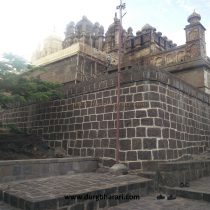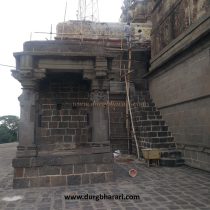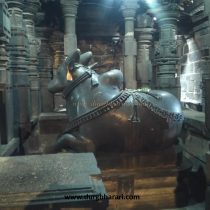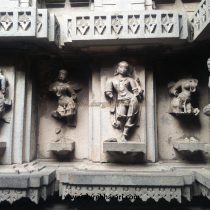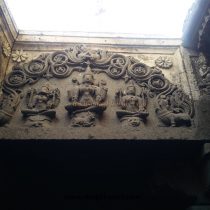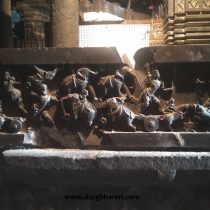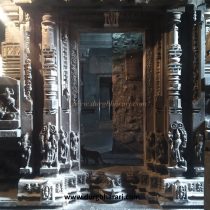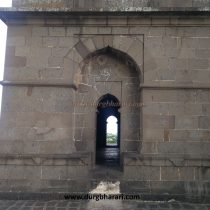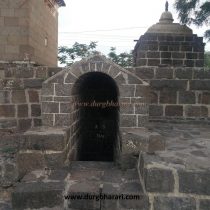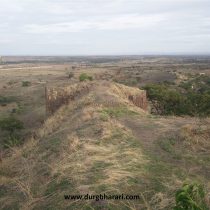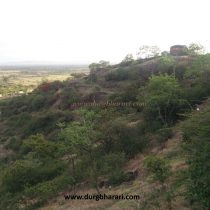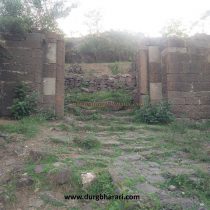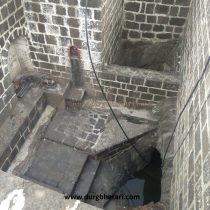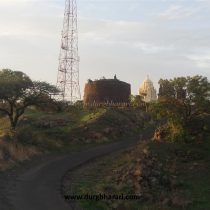DAULATMANGAL
TYPE : HILL FORT
DISTRICT : PUNE
HEIGHT : 2670 FEET
GRADE : EASY
The Shiv temple of Bhuleshwar is famous in Malshiras village in Purandar taluka of Pune district, but the fort in which this Shiv temple is located has been forgotten today. Many people have no idea that the Bhuleshwar temple is in the fort. Daulatmangal fort is located near Yavat in the Bhuleshwar mountain range, which stretches from east to west in the Sahyadri to the south of Pune city. Daulatmangal fort is 61 km from Pune via Dive Ghat from Saswad-Amble-Malshiras and 56 km from the Pune-Solapur highway via Yavat. Bhuleshwar temple is at a distance of 8 km from Yavat village. The road has come to Bhuleshwar temple by breaking some of the ramparts of the Daulatmangal fort. On the way to the temple by car, you can see the fort gate, steps, and fortified bastions. Bhuleshwar temple is the main and very beautiful building on this fort.
...
. (Bhuleshwar temple is briefly described in the section of the temple of the Durgbharari website.) If you come by private vehicle, you will come directly to the top of the fort, so the tour of the fort starts from there. Bhuleshwar temple is located in the highest part of the fort and is built on a quadrangle structure about 8 feet high. The height of the fort is 2680 feet above sea level and 620 feet from the base. The hill of the fort is spread from south to north and the area of the fort is about 8 acres. As you climb the newly built staircase of the quadrangle structure, you see statues of gatekeeper Jai and Vijay on the wall next to the steps. Next to the idol on the right is a sculpture of a lion attacking an elephant and on the upper side is a sculpture of a hero fighting with a lion. In front of the main temple is a huge brass bell with a turtle carved in stone under it. Built-in the 12th century, the lower part of the temple is built of black basalt stone and the roof is made of bricks and plastered with lime. This limestone plaque has fine carvings as well as sculptures of deities like Ganapati, Vishnu, Bhairav, Durga, Nrusinha, etc. This shows that the temple has been renovated in recent times. Upon entering the temple, we first come to the town hall and then to the prayer hall. Both these buildings outside the main temple were built in later periods. There is a wall in front of the main temple which stands on a high pedestal from this hall and there are steps on both sides. When you reach the first floor by the steps, you can see a big 6 feet high Nandi carved in black stone and a turtle beside it. After seeing Nandi, Shivling and their images are seen inside. Around the temple, events from Ramayana and Mahabharata are engraved on the outside of the pavilion. A large number of these statues carved on the walls have been deliberately destroyed. The interior of the temple is dark and the black stone used in the construction makes you feel cool. On the left side of the temple, there is a quadrangle structure with a carved pillar on it and the roof on the upper side is made out of stone. The Nandi in the temple may have existed since ancient times. From here there are steps to reach the roof of the temple. The back of the temple is covered with limestone and next to it is a domed structure. There are steps to go to the front of the temple and there is a Deepmal next to these steps. Adjacent to the Deepmal is a long stone warehouse with a basement and a temple of Lord Shiva in front. From this temple, your fort round begins. If you walk straight from the ramparts near the temple, you will reach the bastion at the eastern end of the fort. There was a gate to the fort in this area, but it has been destroyed over time. From this bastion, one can see the ruins of the settlement at foothills as well as a dilapidated mosque. From this bastion, one can see the main entrance of the fort and the adjoining ramparts. The fort still has a large amount of construction left, but it has fallen into disrepair and has been neglected. When we go to the temple on the other side of the ramparts, we come to a Samadhi which is on a quadrangle structure under the temple, but it is not possible to say whose Samadhi this is. From here, as you start descending the newly constructed steps of the fort, you will see a two-storied stone structure with steps on the left side. A large natural cave can be seen in the recent part of this building. Some amount of water has accumulated in this cave and due to lack of sanitation, garbage has also accumulated here. At the front of the cave, there is the main path leading to the fort, and the fort's gate, which is fortified on this path, is still intact today. Currently, a monk is residing here. A bastion can be seen in the ramparts adjacent to this gate. A short distance below here is the east-facing gate of the fort built on the base of a bastion. Although the door frame remains, the upper arch has completely collapsed. In front of the gate, there is a quadrangle structure in the interior of the fort. When you go straight ahead without going down through the main gate, you will come across a big rectangular shaped deep tank built in the rock. There are steps to get down in this tank and there are two cisterns carved in the rock inside this tank. One of these cisterns is used for drinking water. The wall of this tank has some carved sculptures of saints. In front of this tank, a stone basin can be seen. After going ahead this way, you come to a paved road going to the fort. On the other side of the road, there are three bastions of the fort, two bastions are round and are hexagonal. Inside this hexagonal bastion is a temple of Janabai built of wrought stone and on the lower side of this bastion, there is a water cistern carved in the rock. Currently, this cistern is dry. On the upper side of the cistern are some broken Shivlings. On the way back to the road where your car is parked, you can see a circular bastion and a sloping door. The bastion inside the fort must have been built to guard the interior of the fort. The Archaeological Department has declared the temple and its surroundings as a National Protected Site. From the fort, the region up to Purandar-Vajragad, Malhargad, Jejuri, Dhawalgad can be seen. It takes two hours to see the Bhuleshwar temple and the entire fort. Due to the Shiv temple at Bhuleshwar on the Daulatmangal fort, this place is directly connected with the Purans. According to a Puran story, Parvati danced here to attract Mahadev, so the place got the name Bhuleshwar and they got married here and went to Mount Kailash. In the 12th century, the Yadavs built a Bhuleshwar temple at this place. Fatehmangal of Phaltan, Subhanmangal of Shirwal, and Daulatmangal of Bhuleshwar are mentioned before the Shivaji Maharaj period. After the assassination of Shahaji Raja's father-in-law Lakhuji Jadhav and his sons in the 16th century, Shahaji Raja left the Nizamshahi and took over the ancestral land of Pune and surrounding areas with the idea of establishing an independent state. On this Adilshah sent a large army with the commander in chief named Rairao to Pune and destroyed Pune. Murar Jagdev was a great chief of Adilshah's court. He and Shahaji Maharaj had a good relationship. After Adilshah's forces invaded Pune, Murar Jagdeo built a fort around the hill of Bhuleshwar temple near Pune in 1629 and built a fort and moved the military and civil affairs of Pune province there. The fort got the name Daulat Mangal due to the shrine of Goddess Mangalai to the south of Bhuleshwar Temple. Until the assassination of Murar Jagdeo in 1635, the affairs of Pune province were governed from the Daulatmangal fort. After that, when Jijabai and Shivaji Maharaj rebuilt Pune and started ruling from Lal Mahal, the importance of Daulat Mangal fort decreased. These temples were renovated in 1737 by Brahmendraswamy, the first Guru of Bajirao Peshwa and Shahu Chhatrapati. At a cost of one lakh rupees, Brahmendraswamy erected a three-arched town hall, prayer hall, and three pinnacles plastered with limestone and a bastion besides this. This construction was done by Sambhaji and Vyankoji Naik. Damaji Gaikwad donated Rs. 25,000 to the temple charity for his victory over Pawar. It is recorded in the Peshwa office that after the victory of Vasai, Chimaji Appa offered Rs. 125 for the crown of the idol in Bhuleshwar temple and he also offered one hundred and twenty-five gold statues.
© Suresh Nimbalkar

